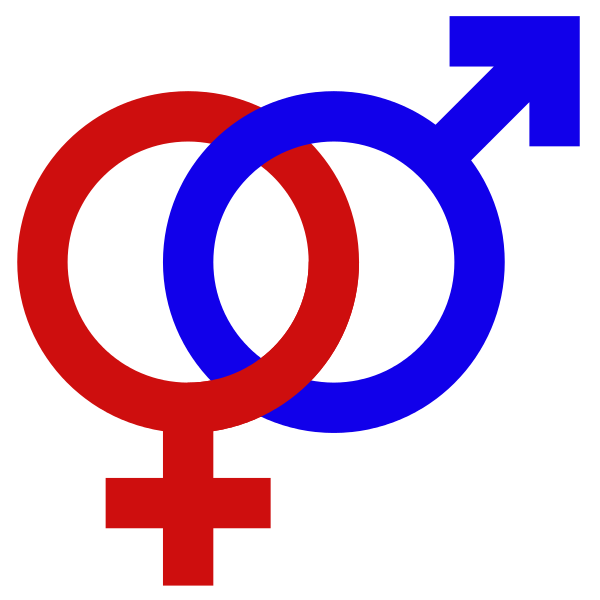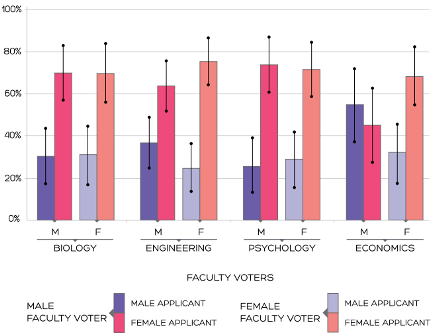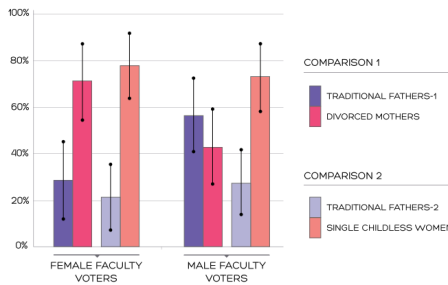You have /5 articles left.
Sign up for a free account or log in.

Wikimedia Commons
Many studies suggest that women scientists aspiring to careers in academe face roadblocks, including bias -- implicit or overt -- in hiring. But a new study is throwing a curveball into the literature, suggesting that women candidates are favored 2 to 1 over men for tenure-track positions in the science, technology, engineering and math fields. Could it be that STEM gender diversity and bias awareness efforts are working, or even creating a preference for female candidates -- or is something more nuanced going on? Experts say it’s probably both.
Wendy M. Williams, professor of human development at Cornell University, and Stephen Ceci, the Helen L. Carr Professor of Developmental Psychology at Cornell, are no strangers to complicating research on gender bias in STEM. In a 2010 paper in the Proceedings of the National Academy of Sciences, for example, they argued that women’s life choices, whether voluntary or constrained, better explain women’s underrepresentation in STEM than the usual suspects of discrimination in journal and grant reviewing and hiring. (They argued such biases were things of the past, and that efforts to address them missed the real source of the problem.)
But the pair’s new experimental paper -- also in PNAS -- is an effective takedown of that last assumed bias: hiring, especially in math-intensive disciplines. They argue that past studies of gender bias in STEM hiring don’t focus on faculty positions, where there isn’t really a problem.
“Although the point of entry into the professoriate is just one step in female faculty’s journey at which gender bias can occur, it is an extremely important one,” the paper says. “We hope that the discovery of an overall 2 to 1 preference for hiring women over otherwise identical men will help counter self-handicapping and opting out by talented women at the point of entry to the STEM professoriate, and suggest that female underrepresentation can be addressed in part by increasing the number of women applying for tenure-track positions.”
Williams’s and Ceci’s study, called “National Hiring Experiments Reveal 2-to-1 Faculty Preference for Women on STEM Tenure Track,” involved 873 science and engineering faculty members at 371 colleges and universities in the U.S. In four randomized, controlled experiments, faculty members evaluated narrative summaries describing hypothetical men and women candidates for assistant professorships in biology and psychology (where women are relatively well represented) and engineering and economics (where women are substantially underrepresented). In a last experiment, engineering faculty members looked at fictitious candidates’ full résumés.
In most of the experiments there were three candidates, Drs. X, Y and Z. Two of the three candidates -- one man and one woman -- were exceptional, with identical near-perfect academic qualifications. A third “foil” candidate -- a man -- was excellent, but not of the same caliber. Along with the foil, a series of narratives were created using different adjectives to describe the two top candidates. Some narratives for men and women featured traditionally male descriptors (“powerhouse,” “ambitious”) and some traditionally female (“imaginative,” “likable”); the researchers hoped that both design features would help disguise the purpose of the study. The researchers also conducted an experiment in which faculty members rated only one candidate -- a man or a woman, not both -- in order to compare the results of the other experiments with one that was highly unlikely to elicit socially desirable responses in favor of the woman.
Gender differences were only explicitly noted only by a pronoun -- “he” or “she.”
Beyond qualifications, the researchers varied some of the candidates’ life characteristics -- such as being a single mother or having a stay-at-home spouse or having taken parental leave in the past. The idea was to "illuminate contextual factors in faculty decision making."
Somewhat surprisingly, faculty reviewers in all four disciplines strongly preferred female candidates to male candidates, even in the single-candidate control experiment; the only exception was men economists, who showed no gender preference either way.

Source: Proceedings of the National Academy of Sciences
In the experiment comparing family situations, women preferred divorced mothers to married fathers (71 percent vs. 29 percent, respectively). Men reviewers were neutral on that issue but they preferred mothers who took extended leaves to those who did not, 2 to 1. Women slightly preferred the women candidates who did not take extended leaves. Both men and women faculty members strongly preferred single, childless women over traditional fathers. In all these examples, the comparisons are between fake candidates with comparable academic credentials.

“Our data suggest it is an auspicious time to be a talented woman launching a STEM tenure-track academic career, contrary to findings from earlier investigations alleging bias, none of which examined faculty hiring bias against female applicants in the disciplines in which women are represented,” the authors conclude. “The perception that STEM fields continue to be inhospitable male bastions can become self-reinforcing by discouraging female applicants, thus contributing to continued underrepresentation, which in turn may obscure underlying attitudinal changes.”
Williams said in an email interview that the study built on her and Ceci’s existing research. In particular, a previous hiring analysis revealed that women were a smaller fraction of the applicant pool for faculty positions in STEM, but those who applied were given jobs at a higher rate than the men who applied. But those real-world hiring data didn’t take into account differences in applicants’ accomplishments, she said. The new study aimed to test whether women received more job offers, controlling for their qualifications relative to men.
Despite her and Ceci’s previous work busting dominant theories about gender bias in STEM hiring, Williams said they were still not expecting the results they observed.
“At one point we turned to each other while we were coding email responses from faculty across the U.S. and said we hoped that the large preference for women applicants over identically qualified men applicants would slow down because it seemed too large to be believed!” she said. “It never did slow down, and the final tally was roughly a 2 to 1 preference. So, we were surprised.”
She added, “If the data had come out 50-50, we would not have been surprised, because I think we expected a level playing field.”
The study met mixed results from other experts on gender bias in STEM.
Ernesto Reuben, an assistant professor of management at Columbia University, published a paper in PNAS last year suggesting that hiring managers in STEM prefer men for a mathematical task when they have no other information than the candidate’s gender. He said Williams’s and Ceci’s study is methodologically sound and actually complements his own research.
“The article presents evidence of a preference for a female candidate over a male when both performance and lifestyle are identical,” he said of the new study. “This is an important finding and is in fact what I would have hoped to see.” Why? Because there's no sign of “taste-based discrimination" -- or discrimination based on gender alone.
Reuben said the difference between his article and Williams’s and Ceci’s is that while they are “looking at hiring practices controlling for performance and lifestyle, I look at how individuals make inferences about performance based on gender.” In other words, he said, “how gender serves as a signal for performance and lifestyle" -- what economists call statistical discrimination. In real-life hiring decisions, Reuben added, "men and women do usually have different lifestyles and therefore the next question to ask is why they make such choices.”
Joan C. Williams (no relation to the Cornell researcher), 1066 Foundation Chair and founding director of the Center for WorkLife Law at the University of California's Hastings College of Law, is coprincipal investigator of Tools for Change in STEM, a long-term research project on women in the sciences. Joan Williams also said the study’s methodology was sound, but that it was “seriously flawed” in its conclusion that STEM is now a positive place for women because hiring may not be discriminatory.
Ongoing research by Joan Williams suggests that 100 percent of women scientists (of 60 surveyed) have faced gender bias -- once they’re on the job. Any study that ignores climate and retention issues beyond the hiring phase isn’t painting an accurate picture of the field, she said.
“There are many studies that focus only on hiring, and that’s a totally legitimate thing to do,” Joan Williams said. “The problem is the way they’ve interpreted their conclusion, which is far too broad, because this effect in hiring isn’t really the problem with gender bias in STEM.”
Joan Williams said the study suffered from another major flaw -- that the woman candidate is so extraordinary in her qualifications that she is almost impossible not to hire; it’s a phenomenon known as “shifting standards,” she said.
For reference, a sample narrative included in the study of a female candidate who is a married mother of two young children reads in part: "Z's recommenders all especially noted her high productivity, impressive analytical ability, independence, ambition and competitive skills, with comments like, 'Z produces high-quality research and always stands up under pressure, often working on multiple projects at a time.' They described her tendency to 'tirelessly and single-mindedly work long hours on research, as though she is on a mission to build an impressive portfolio of work.'"
A study in which the hypothetical candidates were highly qualified but perhaps not so ideal, or in which they demonstrated a bit more work-life balance, might have yielded more telling results, Joan Williams said. “The problem is with most of us who are merely excellent. That’s where the problem lies.”
Christianne Corbett, senior researcher at the American Association of University Women, agreed that most gender bias probably occurs among excellent but not “superstar” candidates. She noted that a highly publicized PNAS study from 2012 -- which suggested that the same hypothetical student candidate for a lab manager position fared much better when he was given a man’s name than a woman’s -- specifically controlled for that possibility (the candidate had qualifications that were great but not superb, by design).
Corbett said she thought that that study and others like it, along with more pointed gender bias awareness efforts, might be shifting the hiring landscape for women so much that there's now a bias toward them. She said that wouldn't necessarily be a bad thing, however, since women professors have a lot of ground to cover in STEM -- especially in fields such as engineering and computer science; according to a recent report from AAUW, for example, just 23 percent of assistant professors in engineering are women, up from 18 percent in 2004.
More women professors mean more mentors and models for women who may not believe that academic life is compatible with family life, Corbett said.
“I think it would be a shame if some did take the evidence as a reason to go back the other way,” she added. “We certainly have not gotten where we want to be.”
Wendy Williams rejected the idea that her hypothetical candidates were too qualified to yield realistic results, saying that candidate shorts lists -- such as the ones that the faculty members in the study reviewed -- are simply "always superb." She also disputed the idea that the paper presented hiring as the sole problem facing women in STEM.
In other words, she said, hiring bias "doesn’t have everything to do with the shortage of women in math-intensive fields, as many claim, but hiring is an important transition point because if you are not hired you cannot persist, get tenured, etc."
That said, Wendy Williams admitted that her findings “will probably lead some readers to be unhappy, particularly men with equivalent accomplishments.”
Does this suggest that gender diversity efforts are no longer needed, she asked. “We dodged this question by encouraging those with policy expertise to discuss this as neither of us are policy wonks.”





